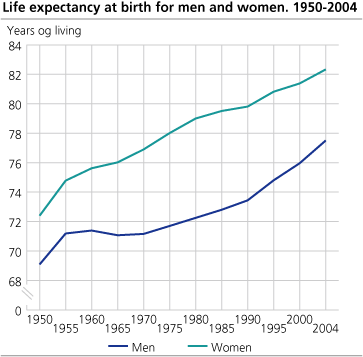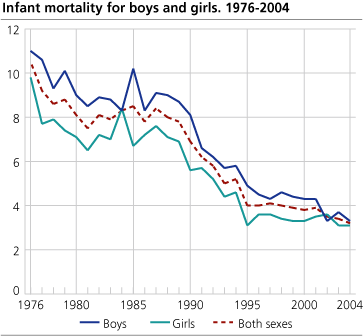Content
Published:
This is an archived release.
Life expectancy still increasing
Life expectancy for both men and women continues to rise. In 2004, life expectancy increased by 0.46 years for men and 0.40 years for women. Life expectancy at birth for men was 77.5 years, compared with 82.3 for women. Infant mortality declined further and is one of the lowest in the world. Last year 3.2 children per 1 000 live birth died before age one.
Life expectancy is continuing to rise sharply. In the last six years, it has increased by two years for men and one year for women. The difference in life expectancy between men and women decreased to 4.8 years in 2004, compared with 5.8 years in 1994. This may be related to more similar living conditions for men and women, especially with regard to smoking habits. The average life expectancy in Western Europe is 75 years for men and 81 years for women.
Lower infant mortality
Last year, 185 children under the age of 1 died, 99 boys and 86 girls. From 2003 to 2004 the infant mortality rate in Norway fell by 0.2 to 3.19, and is one of the lowest in the world. The infant mortality rate for boys declined to 3.33 in 2004 and remained more or less unchanged for girls.
1 200 fewer died than in 2003
In 2004, 41 200 people died, 20 000 men and 21 200 women. This is approximately 1 200 fewer than in 2003. More women than men died, but this is due to the population's age composition, with more elderly women than men. 78 per cent of those who died were 70 years or older. The mortality of elderly people continued to decline, and in 2004 life expectancy for people aged 70 increased by 0.3 years for men and 0.4 years for women.
Tables:
Contact
-
Anders Sønstebø
E-mail: anders.sonstebo@ssb.no
tel.: (+47) 46 66 37 74
-
Magnus Haug
E-mail: magnus.haug@ssb.no
tel.: (+47) 40 81 14 91
-
Ane Margrete Tømmerås
E-mail: ane.tommeras@ssb.no
tel.: (+47) 91 99 29 62
-
Statistics Norway's Information Centre
E-mail: informasjon@ssb.no
tel.: (+47) 21 09 46 42
-
Oppdrag befolkningsstatistikk
E-mail: befolkning@ssb.no


